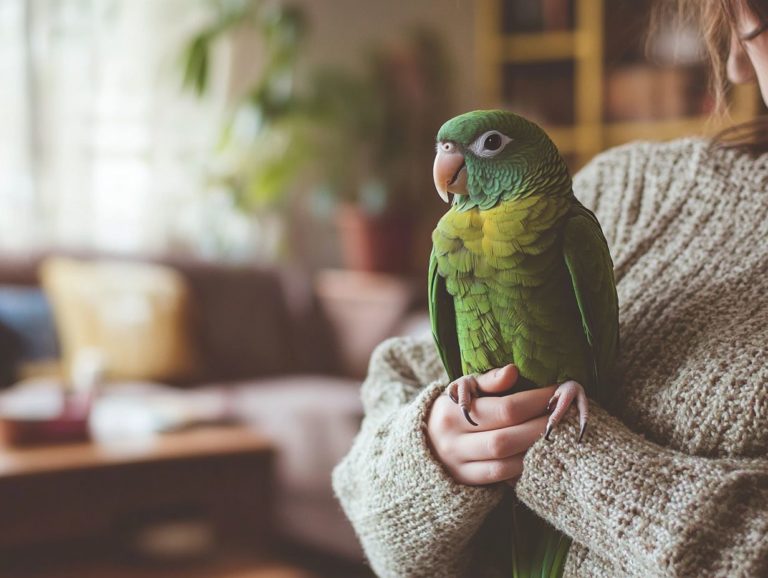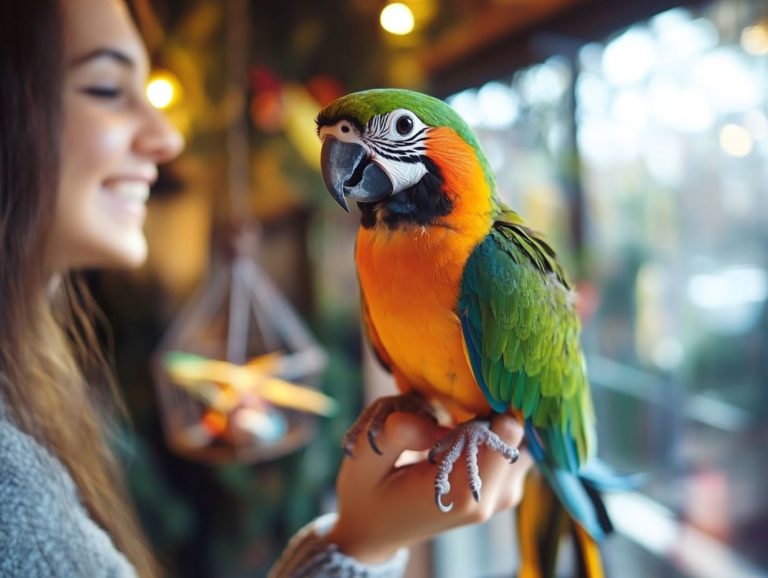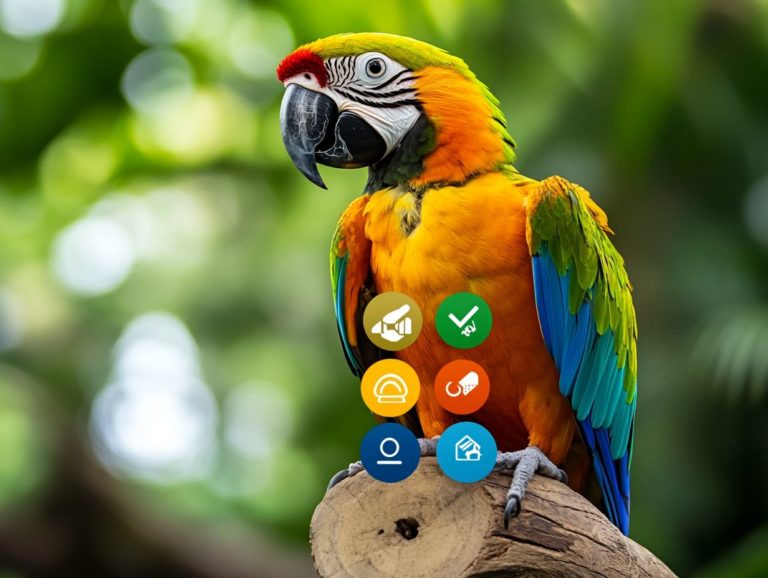5 Essential Commands Every Bird Should Know
Teaching your bird essential commands can truly transform your relationship and elevate the communication between you and your feathery companion.
In this article, you’ll discover five key commands to know such as “Step Up” and “Stay” that every bird should master. You’ll also delve into the benefits of training, tips for achieving success, and common pitfalls to steer clear of.
Whether you re a seasoned bird owner or just embarking on your avian journey, mastering these commands can pave the way for a happier, more harmonious home.
Let’s dive into the fun world of bird training and discover how to transform your bond with your feathery friend!
Contents
- Key Takeaways:
- 1. “Step Up” or “Perch”
- 2. “Step Down” or “Off”
- 3. “Come Here” or “Recall”
- 4. “Stay” or “Wait”
- 5. “No” or “Stop”
- The Importance of Teaching Commands to Your Bird for Better Behavior
- Frequently Asked Questions
- What are the 5 essential commands every bird should know?
- How can I teach my bird the “step up” command?
- Why is “stay” an important command for birds to learn?
- Can birds be trained to come when called?
- How can I teach my bird to be quiet on command?
- Is it possible to teach older birds these essential commands?
Key Takeaways:
- “Step Up” or “Perch”: Teaches your bird to hop onto your hand or a perch, making it easier to handle.
- “Step Down” or “Off”: Helps your bird learn to safely exit from your hand or perch, preventing accidents.
- “Come Here” or “Recall”: Crucial for calling your bird back to you, keeping it safe during flight.
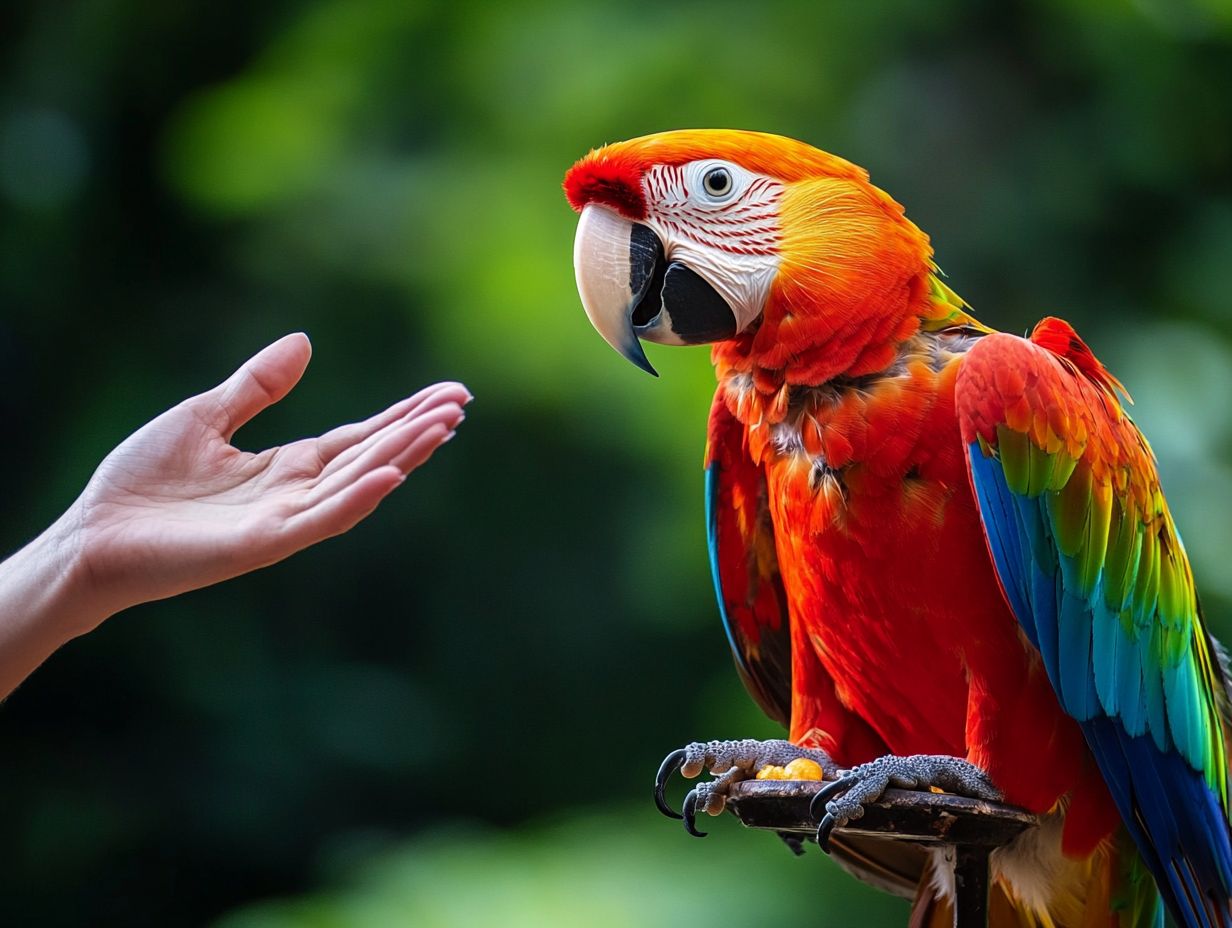
1. “Step Up” or “Perch”
Training your bird to respond to the ‘Step Up’ or ‘Perch’ command is essential for being a responsible bird owner. It promotes safe handling and strengthens the bond between you and your feathered friend.
This command holds particular significance for attentive species like African gray parrots. Consistent practice can lead to dependable obedience, ensuring safety and cooperation.
By using techniques recommended by experts like Dr. Laurie Hess, you can create a secure environment where your bird feels eager to engage in training. Rewarding your bird when it does well like giving it treats or using a happy voice creates a sense of achievement and encourages further learning.
This method highlights the value of patience; behavioral changes often take time. Recognizing this can make the training enjoyable for both you and your bird. Focus on gentle cues and consistent routines to help your bird connect the command with positive outcomes, deepening the trust and bond you share.
2. “Step Down” or “Off”
The ‘Step Down’ or ‘Off’ command is vital for you as a bird owner. It teaches your feathered friend to exit your hands or perches safely, ensuring the safety of both you and your pet during interactions.
This command helps cultivate a trusting relationship with your bird and prevents accidents that could lead to injuries. Keep training sessions short and regular for the best results. Verbal praise serves as a great motivator, helping your pet associate the command with positive experiences.
Using special treats can further reinforce this behavior, making the learning process enjoyable for both of you. Remember to stay patient and calm birds are perceptive creatures who can sense your emotions, creating a supportive training environment.
3. “Come Here” or “Recall”
Teaching your bird the ‘Come Here’ or ‘Recall’ command is a pivotal technique that enhances reliable recall and strengthens your bond with your feathered friend. It ensures safe interactions and freedom during supervised flight.
This command acts as a crucial safety net, allowing your bird to return at a moment s notice and reducing risks associated with free flight. Start in a familiar, distraction-free environment. Using enticing treats like seeds or fruit can greatly motivate your bird.
Verbal praise is equally important; using a happy voice when your bird comes to you reinforces positive behavior. With consistent practice of these techniques, you ll nurture trust and understanding, turning training into a delightful experience that deepens your connection with your avian companion.
4. “Stay” or “Wait”
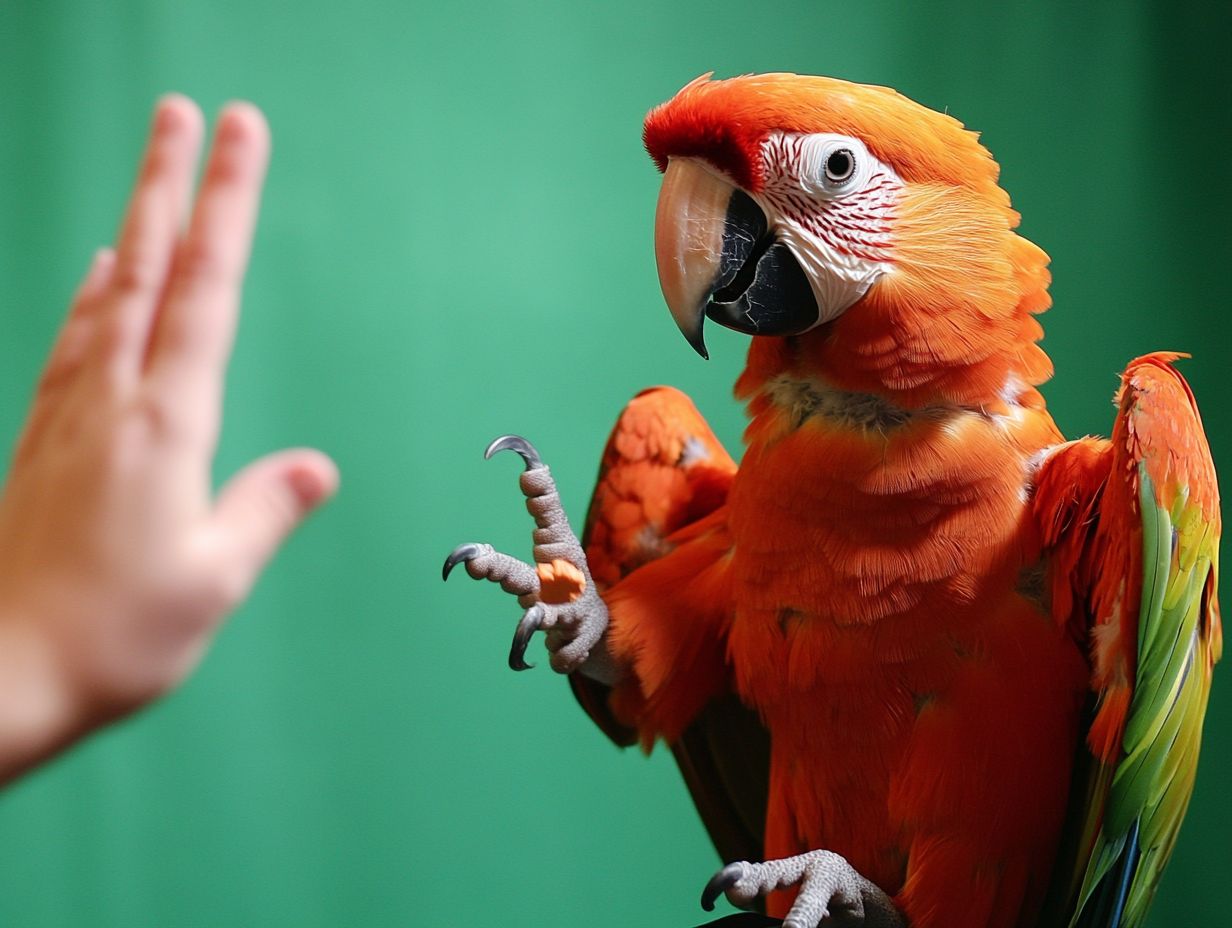
The ‘Stay’ or ‘Wait’ command is essential in your bird training journey. It teaches your feathered friend to remain in a specific position until you provide further instructions. This helps in teaching your bird to be patient and listen, giving you greater control over your clever and lively pet.
By introducing this command early on, you lay a solid foundation for advanced behaviors down the line. During training sessions, using treats and praise as rewards is a highly effective approach. For instance, when your bird successfully holds its position for a few seconds, reward it with a favorite snack, like a piece of fresh fruit. This motivates your bird to stay still and strengthens the bond of trust between you two.
Practice this exercise daily even in short bursts to achieve remarkable results. Your bird will learn to associate staying put with delightful rewards.
5. “No” or “Stop”
The ‘No’ or ‘Stop’ command is crucial in animal training, serving as a critical signal for your bird to halt unwanted behaviors. This ensures the safety of both your pet and its surroundings, creating a positive training environment.
Mastering this command helps you manage undesirable actions and deepens the bond between you and your bird. Using positive reinforcement techniques like treats or praise when your bird responds correctly makes learning a delightful experience. You can find more exciting methods, such as 5 fun tricks to teach your budgie, to enhance this process. Ensure your verbal cues are clear and consistent so your bird can easily associate the command with the desired behavior.
Staying calm helps your bird feel safe and encourages it to participate confidently. Birds are highly attuned to their handler’s emotions, so maintaining a calm demeanor is crucial.
The Importance of Teaching Commands to Your Bird for Better Behavior
Understanding the significance of teaching commands to your bird is crucial for you as a bird owner. Not only does it enhance communication, but it also safeguards both your pet and its surroundings. This fosters a deeper bond through effective interaction and training techniques.
By implementing structured training sessions, you can teach your feathered friend a variety of commands, leading to better behavior management. This practice helps your bird understand what you want, making life more enjoyable for both of you while reducing unwanted behaviors.
Employing positive reinforcement methods using treats and praise as rewards promotes learning and strengthens the emotional connection between you and your bird. As trust develops through consistent training, you’ll likely notice your bird becoming more responsive and engaged, enriching your relationship and paving the way for a joyful companionship.
What Are the Benefits of Teaching Commands to Your Bird?
- Enhanced behavior management
- Improved bonding with you
- Greater opportunities for interaction
Teaching commands to your bird offers a multitude of advantages that enrich both your pet’s life and their learning experience.
Incorporating command training into your routine can significantly transform your daily interactions with your feathered companion. This approach nurtures a deeper connection and provides a proactive method for curbing undesirable behaviors.
For instance, using positive reinforcement like treats or praise when your bird successfully follows a command can dramatically boost its motivation to learn. Over time, this fosters increased engagement, ensuring your bird remains mentally stimulated and, ultimately, happy.
Want to make your bird training more effective? Start with these 5 steps to successfully train your bird today for a happier, more obedient pet!
What Are Some Tips for Teaching Commands to Your Bird?

Teaching commands to your bird can be fun and rewarding! Effective training requires a strategic approach. By incorporating techniques such as rewarding your bird (giving treats or praise when your bird does well), maintaining consistency, and practicing patience, you can significantly enhance your success in teaching commands.
Birds are intelligent creatures, and understanding their unique learning styles can truly transform your training experience. When your bird earns treats or praise for following commands, it builds a positive association with learning.
Consistency is equally crucial. Make sure your training sessions are engaging yet brief to keep their focus sharp. Approaching training with a mindset of patience not only makes the experience more enjoyable, but also allows both you and your bird to celebrate the small victories along the way.
What Are Some Common Mistakes to Avoid When Teaching Commands to Your Bird?
As a bird owner, you should be mindful of common mistakes that can arise when teaching commands. Inconsistency, impatience, and neglecting the importance of rewarding your bird can significantly hinder your training efforts and the development of the behaviors you desire.
These frequent pitfalls strain the bond between you and your bird and can lead to frustration for both of you. If you lack consistency in your commands or cues, your bird may become confused, resulting in mixed signals and slower progress.
Impatience during training sessions can create a tense atmosphere, making your bird less willing to engage. Establish a consistent training routine to avoid these issues. Use clear and unwavering commands, and prioritize rewarding your bird like treats or praise to encourage good behavior. This approach improves training and builds a stronger connection between you and your bird.
How Can You Reinforce Commands with Your Bird?
Reinforcing commands with your bird is essential for cementing your training success. By employing techniques like rewarding your bird, verbal praise, and delicious treats, you can significantly enhance the training process while also deepening the bond between you and your bird.
These strategies do more than just enable your bird to learn; they cultivate a trusting relationship. When you utilize rewarding techniques, you create an environment where your pet feels safe and is eager to respond to your cues.
For example, offering a small treat right after your bird follows a command can greatly boost its motivation to repeat that behavior. Coupled with enthusiastic verbal praise, you send a clear message that your bird is on the right track.
Consistency is key. By maintaining a routine in your training sessions, you help your bird grasp what’s expected, leading to faster mastery of commands and a happier, more engaged companion.
What Are Some Additional Commands You Can Teach Your Bird?
Beyond the basics, you can explore a whole array of additional commands to teach your bird. Consider checking out 5 tips for training older birds to enhance interaction, improve behavior, and provide important mental stimulation for a more enriching companionship.
Consider introducing commands like “wave,” “spin,” or “dance.” These tricks not only highlight your bird’s intelligence but also deepen the bond between you and your pet. Teaching “wave” adds a playful flair to your interactions, while “spin” turns training into a fun physical activity for your bird. Meanwhile, the “dance” command encourages lively movements that can contribute to better health.
Always remember, rewarding your bird is key to this training journey. Rewarding your bird with treats or affection when they respond correctly amplifies their enthusiasm and eagerness to learn new skills, creating a joyful and engaging training atmosphere.
Frequently Asked Questions
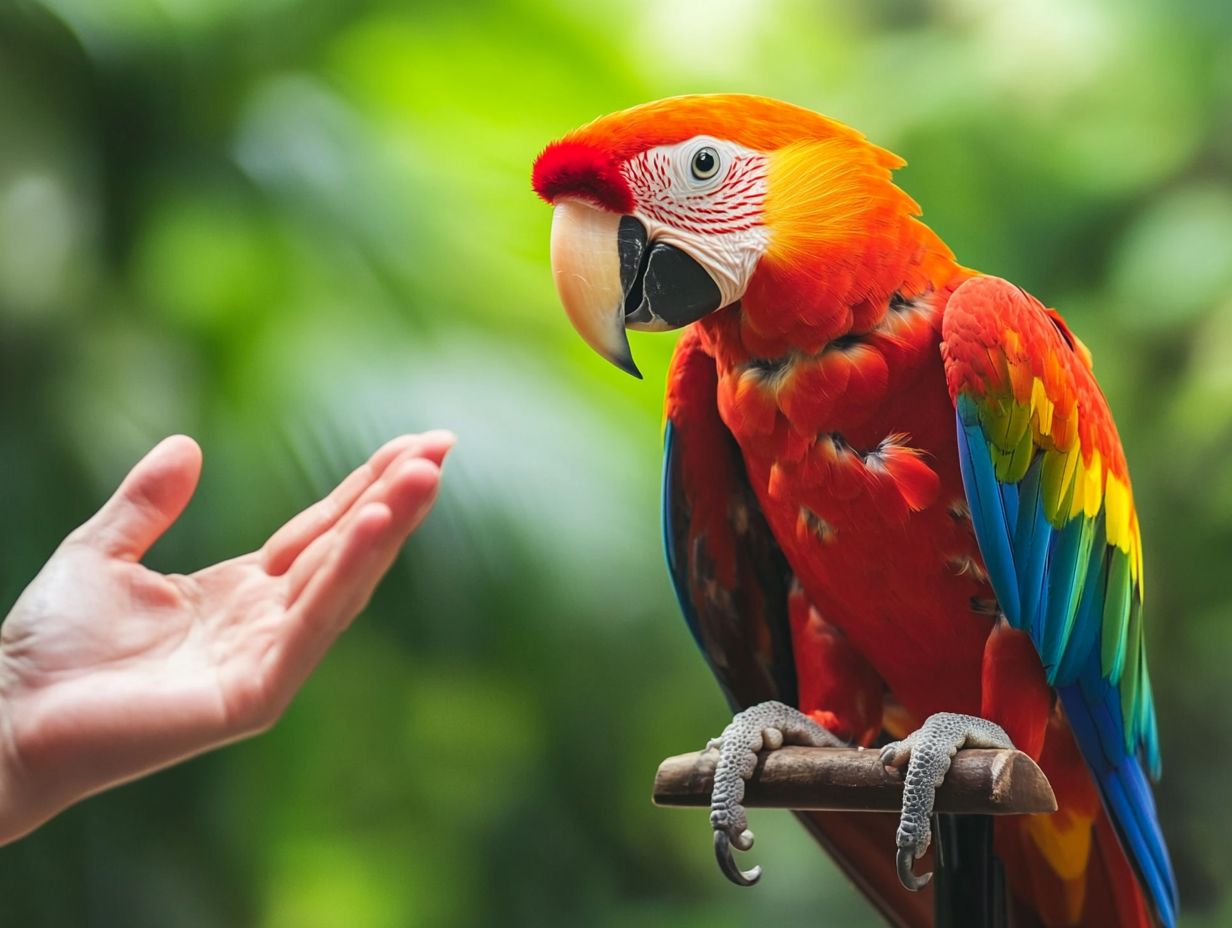
Here are some common questions bird owners ask:
What are the 5 essential commands every bird should know?
The 5 essential commands for parrots every bird should know are “step up,” “step down,” “stay,” “come,” and “quiet.” These commands ensure your bird’s safety and make life easier for you.
How can I teach my bird the “step up” command?
To teach your bird the “step up” command, place your hand near their feet. Say “step up” and gently push their chest. Reward them when they respond!
Why is “stay” an important command for birds to learn?
The “stay” command keeps your bird safe in risky situations, like opening their cage or having visitors. It also builds trust between you and your bird.
Can birds be trained to come when called?
Absolutely! Train your bird to come when called by using a specific sound or phrase every time you offer a treat. Over time, your bird will learn to respond to that sound.
How can I teach my bird to be quiet on command?
To teach the “quiet” command, wait for a moment of silence. Say “quiet” while gently placing your finger on their beak. Reward them when they stop making noise.
Is it possible to teach older birds these essential commands?
Yes, older birds can learn these commands, but it may require more time and patience. With consistent training and rewards, even older birds can benefit greatly!

